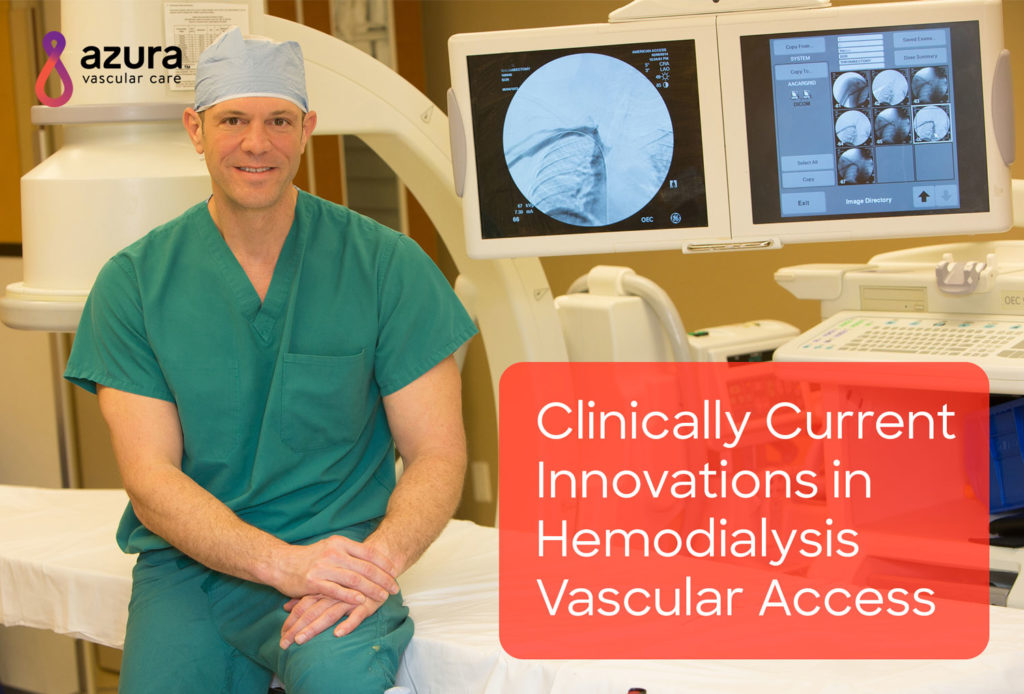
In the article below, Dr. Sor reviews how recently developed techniques for hemodialysis vascular access have demonstrated the potential to minimize or eliminate prolonged reliance on central venous catheters as a dialysis modality.
Since its inception, the arteriovenous fistula (AVF) remains widely acknowledged as the most effective access for hemodialysis in terms of morbidity and mortality. Despite this success, timely placement and development of functional fistulas for hemodialysis remains problematic and results in prolonged reliance on central venous catheters (CVC), which are recognized as the least desirable type of vascular access in terms of morbidity and mortality, or a large percentage of patients with ESRD. Minimizing or eliminating CVC contact time in this patient group is one of the major goals in the dialysis access arena. Recently developed techniques have demonstrated the potential to aid in reaching this goal.
Percutaneous Fistula Creation
Recently, percutaneous anastomosis devices have been developed as an alternative to surgical fistula creation i,ii and have been approved for use in Europe, but are still investigational in the United States.
Early studies on these percutaneous devices compared favorably, or exceeded vascular access benchmarks, such as technical and clinical success, early fistula failure, maturation rate, functional fistula development, and cumulative patency of fistulas, reported in the surgical literature.
Other demonstrated advantages of endovascular fistula creation include the ability to perform AV access creation in an outpatient setting utilizing a minimally invasive technique, widening the group of physicians that are able to create functional AVFs. Access creation in the vascular access center will improve access to this type of care while reducing wait times.
These advantages may contribute significantly to patient satisfaction as well as increasing AVF prevalence and reducing CVC contact time for patients with ESRD.
Bioengineered Blood Vessels
The current alternative to AVF placement is the polytetrafluoroethylene (PTFE) arteriovenous graft (AVG). However, these grafts are prone to thrombosis, infection, intimal hyperplasia at the venous anastomosis and aneurysm formation.
For patients who are not candidates for an AVF, and for whom an AVG is problematic, the alternative is a prolonged period of CVC use, with the associated comorbidities of infection, thrombosis and central vein stenosis, not to mention the economic issues in the context of this scenario.
Recent data suggest that use of novel bioengineered human acellular vessels for hemodialysis access might help to overcome these problems. iii,iv
[sexy_author_bio]
Sources:
i Hull JE, Elizondo-riojas G, Bishop W, Voneida-reyna YL. Thermal Resistance Anastomosis Device for the Percutaneous Creation of Arteriovenous Fistulae for Hemodialysis. J Vasc Interv Radiol. 2017;28(3):380-387.
ii Rajan DK, Ebner A, Desai SB, Rios JM, Cohn WE. Percutaneous Creation of an Arteriovenous Fistula for Hemodialysis Access. J Vasc Interv Radiol. 2015;26(4):484-490. doi:10.1016/j.jvir.2014.12.018.
iii Lawson JH, Glickman MH, Ilzecki M, et al. Bioengineered human acellular vessels for dialysis access in patients with end-stage renal disease: two phase 2 single-arm trials. Lancet. 2016;387(10032):2026-2034.
iv Roy-Chaudhury P. Bioengineered vessels for dialysis access?: soon to be a reality?? Nat Rev Nephrol. 2016;12(9):516-517.
Murat Sor, MD
 Murat Sor, MD, is an interventional radiologist and a leader in the field of vascular and interventional radiology, dialysis access management, and venous insufficiency. Dr. Sor also specializes in minimally invasive treatments for uterine fibroids, peripheral artery disease, varicoceles and more. He is the medical director of HealthQare Associates in Arlington, Virginia.
In addition to his role as HealthQare’s Medical Director, Dr. Sor is Senior Vice President and of Azura Vascular Care and serves on its Medical Advisory Board. Dr. Sor is responsible for developing clinical strategies to ensure that the caliber of medical services Azura centers provide represents the highest standards of quality care and clinical outcomes. Bringing more than 20 years of experience in healthcare performance improvement as a practicing physician, Dr. Sor is the clinical leader of the organization and can best be described as a consensus builder with a collaborative style.
Dr. Sor earned his medical degree at George Washington University School of Medicine after receiving his bachelor's degree from the University of Pennsylvania. He completed his internship at MedStar Washington Hospital Center and his residency in radiology and fellowship in interventional radiology at George Washington University School of Medicine.
Dr. Sor serves as an assistant professor at Georgetown University. Interventional Radiology Fellows rotate through HealthQare Associates as part of their training, gaining invaluable experience in the outpatient vascular access environment.
Dr. Sor has been named as a Washingtonian “Top Doctor” in interventional radiology for the years 2005, 2008 and 2017. He is board certified in diagnostic radiology with a subspecialty certificate in interventional radiology.
Murat Sor, MD, is an interventional radiologist and a leader in the field of vascular and interventional radiology, dialysis access management, and venous insufficiency. Dr. Sor also specializes in minimally invasive treatments for uterine fibroids, peripheral artery disease, varicoceles and more. He is the medical director of HealthQare Associates in Arlington, Virginia.
In addition to his role as HealthQare’s Medical Director, Dr. Sor is Senior Vice President and of Azura Vascular Care and serves on its Medical Advisory Board. Dr. Sor is responsible for developing clinical strategies to ensure that the caliber of medical services Azura centers provide represents the highest standards of quality care and clinical outcomes. Bringing more than 20 years of experience in healthcare performance improvement as a practicing physician, Dr. Sor is the clinical leader of the organization and can best be described as a consensus builder with a collaborative style.
Dr. Sor earned his medical degree at George Washington University School of Medicine after receiving his bachelor's degree from the University of Pennsylvania. He completed his internship at MedStar Washington Hospital Center and his residency in radiology and fellowship in interventional radiology at George Washington University School of Medicine.
Dr. Sor serves as an assistant professor at Georgetown University. Interventional Radiology Fellows rotate through HealthQare Associates as part of their training, gaining invaluable experience in the outpatient vascular access environment.
Dr. Sor has been named as a Washingtonian “Top Doctor” in interventional radiology for the years 2005, 2008 and 2017. He is board certified in diagnostic radiology with a subspecialty certificate in interventional radiology. 

